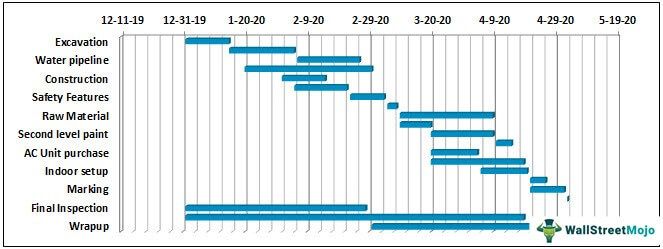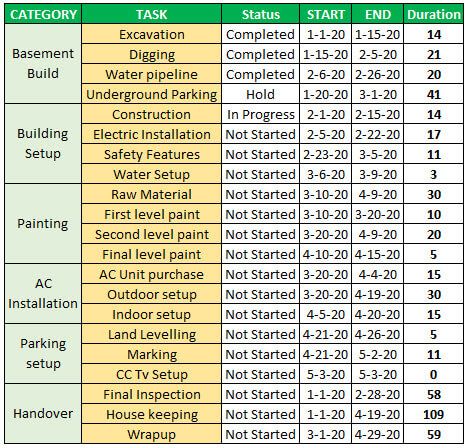Table of Contents
Free Project Timeline Template
A project timeline template is a popular tool used in project management scope or area. It offers immense help to project managers in tracking the timeline, i.e., the start and end date of every task of an entire Excel project timeline template, and plans its completion accordingly in a well-defined manner.

The project timeline template offers a lot of help to every project manager or project engineer who uses this. It is also a very popular tool in project management. It brings about a lot of agility to the scope of tracking or monitoring, where the project manager can easily track every stage or task of the project and plan its completion in a well-organized manner.
Project Timeline Template Explained
A project timeline template is a visual representation that outlines the chronological sequence of activities, milestones, and deadlines associated with a project. It serves as a comprehensive roadmap, offering a clear overview of the project’s schedule and critical milestones.
Typically created at the project planning stage, a simple project timeline template provides a structured framework for project managers and team members to coordinate and track progress. It includes critical elements such as task names, start and end dates, durations, dependencies, and responsible team members.
A well-designed project timeline template offers several benefits:
- Clarity and Communication: It enhances communication by providing a visual reference for team members to understand the project’s timeline, milestones, and deadlines.
- Task Sequencing: The template helps in organizing tasks in a logical order, ensuring that dependencies are identified and managed effectively.
- Resource Planning: By outlining task durations and dependencies, the template aids in allocating resources efficiently and preventing potential bottlenecks.
- Deadline Management: It allows for the clear identification of critical deadlines, helping teams stay on track and meet project timelines.
Project timeline templates are versatile tools that adapt to various project management methodologies. They foster collaboration, transparency, and accountability, ensuring that all team members are aligned with the project’s objectives and deadlines. Additionally, these templates can be easily updated and shared, providing a dynamic and accessible reference throughout the project’s lifecycle.
About the Template
The main utility of the project tracking template is that it captures all the stages crucial for every project completion. Therefore, the template is convenient for every project manager and project engineer. There are a total of four stages or statuses, which we find in this template.
- The first is “complete” status, which means the particular activity is complete.
- The second one is the “In progress” status, which signifies that the activity is under process.
- The third status is the “Hold” one, which means that due to some reasons, the project manager has put a hold on the activity and will soon continue when the situation looks favorable.
Finally, we have “Not Started,” which means the activity has not begun yet, and the project manager will take a call regarding the start of the activity. Based on each task or activity, the project manager allows resources accordingly. On the chance of overlapping tasks with each other, the manager has to take a call accordingly about where he can go for resource sharing or the addition of more resources.
The Excel project timeline template can help in those scenarios if an activity has extended its deadline. In addition, it is a crucial report for project engineers and project managers because it assists them in visualizing the entire project on a piece of paper or computer screen and allotting time accordingly to each activity. The visual chart, which comes with this template, also makes it even more for the project manager or the engineer to understand the different tasks and phases involved in project completion comfortably.
How To Create?
Creating an online or Excel project timeline template involves careful planning, collaboration, and regular updates. A well-structured template enhances project management efficiency and serves as a valuable visual tool for tracking progress and ensuring project milestones are met. Let us understand how to create it through the detailed explanation below.
- Define Project Scope: Clearly outline the project’s objectives, deliverables, and scope to understand the tasks involved.
- Identify Tasks and Milestones: Break down the project into individual tasks and identify critical milestones. List tasks in a logical sequence.
- Determine Task Dependencies: Identify dependencies between tasks, indicating which tasks must be completed before others can start.
- Estimate Durations: Assign realistic durations to each task. Consider the complexity and resources required for accurate estimates.
- Allocate Resources: Assign team members responsible for each task and allocate necessary resources.
- Create a Timeline Structure: Utilize project management software or spreadsheet tools to create a timeline structure with columns for task names, start and end dates, durations, dependencies, and responsible team members.
- Visualize the Timeline: Use Gantt chart features or other visualization tools to represent the timeline graphically. This enhances clarity and makes it easier to understand.
- Include Milestones: Highlight significant milestones within the timeline, providing a quick reference for critical achievements.
- Regularly Update and Review: Periodically update the timeline to reflect actual progress and review it with the project team. Adjust as needed to accommodate changes.
- Share and Collaborate: Share the timeline with the project team and stakeholders. Foster collaboration by encouraging feedback and adjustments as the project progresses.
How To Use?
Now that we understand the basics and how to create a simple project timeline template, let us now delve into how to use it through the step-by-step discussion below.
Part #1
- It is the template section where all the basic information about the project gets captured. It is more personal details based, and the details about the project manager and start and end date of the project get notified. The project name and project manager’s name undertaking the construction are denoted here.
- The initial date when the project name began, from its inception to the estimated end date when the project is to be complete, is mentioned here.
- The end date and start date are crucial to every project manager since the entire activity must plan accordingly, starting from the beginning of the project to completion and handover to the client.
- The total duration field helps us to estimate the number of days, months, or years required for the completion of the project. Both start, and end dates are crucial since they help us build the required Gantt chart, which acts as a visual graph supporting the template.
Part #2

- The most utilized and needed part of every project timeline template is thus the section mentioned above. It generally fills with loads of information based on each task or activity of the project. The project manager plans accordingly based on the information filled in this section.
- Tracking and monitoring each stage or task of the project can happen based on this section. Here we will find the different tasks and further sub-tasks of the project broken down to help the project manager easily monitor the entire project. There are a total of four stages or statuses which we find in this template. The first is “complete” status, which means the particular activity is completed.
- The second one is the “In progress” status, which signifies that the activity is under process. The third status is the “Hold” one, which means that the project manager has put a hold on the activity and will soon continue when the situation looks favorable.
- Finally, we have “Not Started,” which means the activity has not begun yet, and the project manager will take a call regarding the start of the activity. Based on each status, the project manager will allocate resources accordingly to different tasks pending in the project due course.
- We have taken an example of a simple construction project where built a building. The entire project is broken down into more straightforward tasks, and every task has been given a start date and end date. Based on this, the whole project needs to be completed and handed over.
- The handover involves the final wrap-up, housekeeping setting, and completion announcement. In the project, timeline overlapped activities are the areas where the project manager must be cautious and ensure allotted resources and time. Accordingly, it does not hamper any other task.
- This template comes in combination with a Gantt chart, making it even easier for the project manager to understand the different tasks involved. An overview of the Gantt chart will be discussed in the following paragraph.
Part #3
- The Gantt chart is a convenient graph for every project manager. It shows the entire project task schedule based on its start date and duration. Also, the overlap with other tasks is visible to help the project engineer plan the task or deployment of resources accordingly.
- One can easily trace any overlap of tasks here. Thus, it helps project managers allocate resources accordingly. A visual representation always proves beneficial in these scenarios where the project manager or the project engineer wants to control or monitor the entire project based on the start date and end date of each task and activity activity



